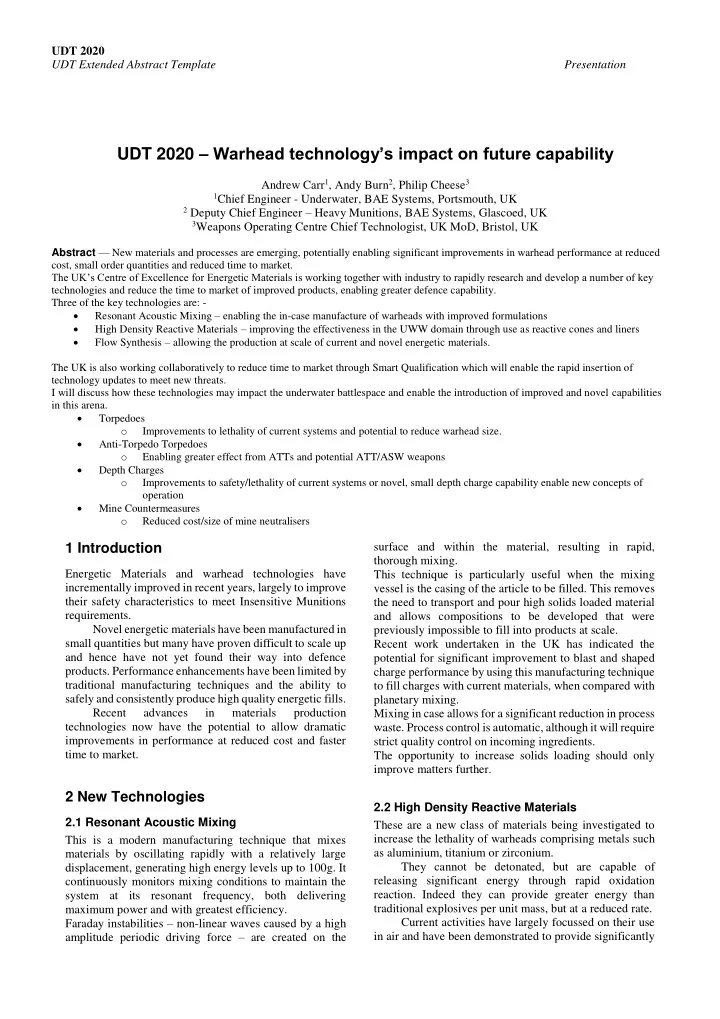

UDT 2020 UDT Extended Abstract Template Presentation UDT 2020 – Warhead technology’s impact on future capability Andrew Carr 1 , Andy Burn 2 , Philip Cheese 3 1 Chief Engineer - Underwater, BAE Systems, Portsmouth, UK 2 Deputy Chief Engineer – Heavy Munitions, BAE Systems, Glascoed, UK 3 Weapons Operating Centre Chief Technologist, UK MoD, Bristol, UK Abstract — New materials and processes are emerging, potentially enabling significant improvements in warhead performance at reduced cost, small order quantities and reduced time to market. The UK’s Centre of Excellence for Energetic Materials is working together with industry to rapidly research and develop a num ber of key technologies and reduce the time to market of improved products, enabling greater defence capability. Three of the key technologies are: - Resonant Acoustic Mixing – enabling the in-case manufacture of warheads with improved formulations High Density Reactive Materials – improving the effectiveness in the UWW domain through use as reactive cones and liners Flow Synthesis – allowing the production at scale of current and novel energetic materials. The UK is also working collaboratively to reduce time to market through Smart Qualification which will enable the rapid insertion of technology updates to meet new threats. I will discuss how these technologies may impact the underwater battlespace and enable the introduction of improved and novel capabilities in this arena. Torpedoes o Improvements to lethality of current systems and potential to reduce warhead size. Anti-Torpedo Torpedoes o Enabling greater effect from ATTs and potential ATT/ASW weapons Depth Charges o Improvements to safety/lethality of current systems or novel, small depth charge capability enable new concepts of operation Mine Countermeasures o Reduced cost/size of mine neutralisers 1 Introduction surface and within the material, resulting in rapid, thorough mixing. Energetic Materials and warhead technologies have This technique is particularly useful when the mixing incrementally improved in recent years, largely to improve vessel is the casing of the article to be filled. This removes their safety characteristics to meet Insensitive Munitions the need to transport and pour high solids loaded material requirements. and allows compositions to be developed that were Novel energetic materials have been manufactured in previously impossible to fill into products at scale. small quantities but many have proven difficult to scale up Recent work undertaken in the UK has indicated the and hence have not yet found their way into defence potential for significant improvement to blast and shaped products. Performance enhancements have been limited by charge performance by using this manufacturing technique traditional manufacturing techniques and the ability to to fill charges with current materials, when compared with safely and consistently produce high quality energetic fills. planetary mixing. Recent advances in materials production Mixing in case allows for a significant reduction in process technologies now have the potential to allow dramatic waste. Process control is automatic, although it will require improvements in performance at reduced cost and faster strict quality control on incoming ingredients. time to market. The opportunity to increase solids loading should only improve matters further. 2 New Technologies 2.2 High Density Reactive Materials 2.1 Resonant Acoustic Mixing These are a new class of materials being investigated to increase the lethality of warheads comprising metals such This is a modern manufacturing technique that mixes as aluminium, titanium or zirconium. materials by oscillating rapidly with a relatively large They cannot be detonated, but are capable of displacement, generating high energy levels up to 100g. It releasing significant energy through rapid oxidation continuously monitors mixing conditions to maintain the reaction. Indeed they can provide greater energy than system at its resonant frequency, both delivering traditional explosives per unit mass, but at a reduced rate. maximum power and with greatest efficiency. Faraday instabilities – non-linear waves caused by a high Current activities have largely focussed on their use amplitude periodic driving force – are created on the in air and have been demonstrated to provide significantly
Recommend
More recommend